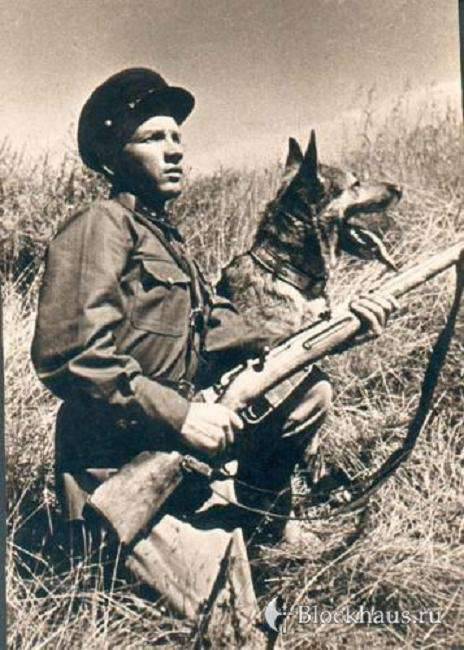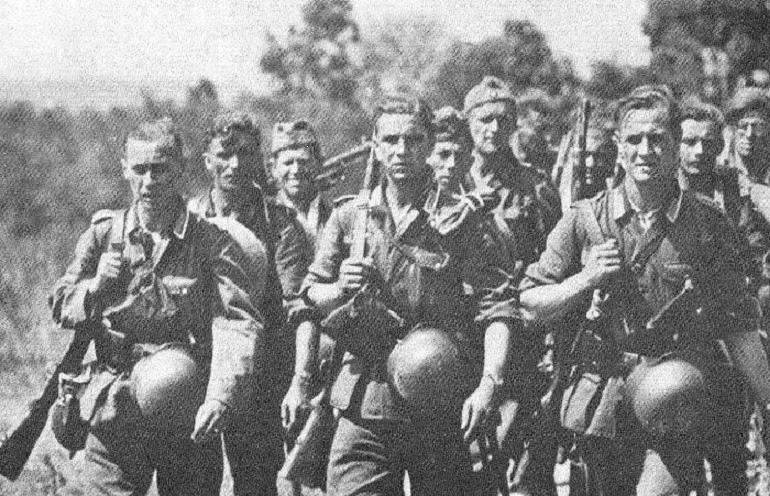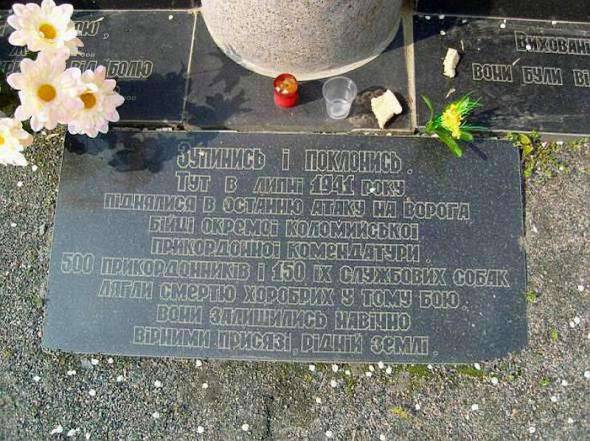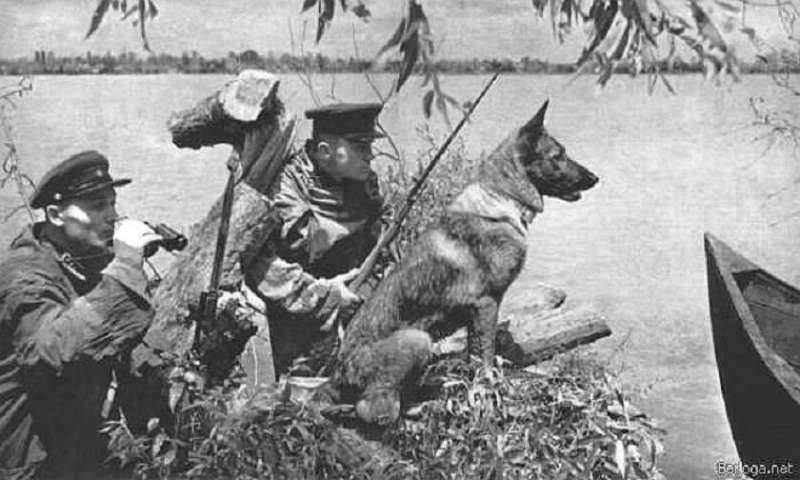The last battle of the "tail company"

History The Great Patriotic War is now overgrown with a mass of myths and legends. Sometimes it is possible to distinguish truth from fiction only by enlisting documentary evidence. The battle that took place on July 30 on the 1941 of the year near the village of Legedzino, Talnovsky district (Republic of Ukraine), is not officially confirmed. This battle was not included in the Sovinformbureau reports, for a number of reasons it does not appear in the combat logs of the Soviet units, information about this battle is not stored on the archives' shelves. It was an ordinary fight, one of many thousands, of those that rattled daily in the smelly of gunpowder and blood of July forty-one. Only scant evidence of eyewitnesses about the last battle of the detachment of border guards and their unusual "tailed company" with the Nazi invaders, and a monument to people and dogs standing on the ancient Uman land confirm that this event, which has no analogues in the history of the Second World War, after all it was.
When a man tamed a dog is not known for certain, some scientists believe that this was accomplished during the last ice age not earlier than 15 thousands of years ago, others put off this date by another 100 thousands of years. However, whenever this happened, the person immediately understood the benefits of working with a shaggy, toothy beast, appreciating his delicate scent, strength, endurance, loyalty and selfless devotion bordering on self-sacrifice. In addition to the use of tamed dogs in various spheres of human activity, in particular during the hunt, as watchmen and vehicles, the ancient military leaders immediately appreciated their fighting qualities. It is not surprising that military history knows many examples when the skillful use of dogs trained for combat had a decisive impact on the outcome of the battle, or on the specific result of a military operation. The first more or less credible references to the fighting dogs that took part in the war date back to 1333 BC. The fresco depicting the army of the Egyptian pharaoh during his next aggressive campaign in Syria, painted big, eared dogs attacking the enemy troops. Fighting dogs served in many ancient armies, it is known that they were widely used by the Sumerians, Assyrians, warriors of ancient India. In the 5 century BC, the Persians, by decree of King Cambyses, began breeding special breeds of dogs designed exclusively for combat. Speaking shoulder to shoulder with the invincible phalanxes of Alexander the Great, the fighting dogs took part in his Asian campaign, four-legged soldiers served in the Roman legions and in the armies of the medieval states. Years passed, weapons and means of defense improved, the scale and tactics of warfare became different. The direct participation of dogs in battles almost disappeared, but the true friends of man still continued to be in the ranks, fulfilling the tasks of protecting, escorting, searching for mines, and also worked as liaison officers, nurses, scouts and saboteurs.
In Russia, the first mention of the introduction into the staffing of military units of service dogs belong to the 19 century. After the October Revolution, in 1919, the now undeservedly forgotten canine scientist Vsevolod Yazykov submitted a proposal to the Council of Labor and Defense about the organization of schools of official dog breeding in the Red Army. Soon the dogs had already served in the Red Army, as well as in various power structures of the young Soviet state. A few years later, throughout the country, official dog breeding clubs and amateur dog breeders' sections were organized at OSOAVIAHIM, who did a lot to staff border, guard and other military units with service dogs. In the pre-war years, the cult of working people, especially representatives of heroic professions, including fighters and commanders of the Red Army — defenders of the socialist Fatherland — actively developed in the USSR. The border guard service was considered the most valiant and romantic, and the type of the border guard, of course, was incomplete without his shaggy four-legged assistant. Movies were made about them, books were published, and images of the famous border guard Karatsyupa and border dog Dzhulbars became almost nominal. Historians of the liberal color of the last quarter of a century, assiduously defaming the NKVD of the USSR and its then leader L.P. Beria, for some reason, they completely forget that this department also included border guards. The frontier troops of the NKVD of the USSR always appear in the archival documents and in the memoirs of the front-line soldiers as the most stable and reliable units for which there were no impossible tasks, because the best of the best were selected for service in the Border Troops and their combat, physical, moral and political training times was considered a reference.
At the beginning of the war, the "green buttonholes" were the first to take the blow of the Nazi aggressors. In the summer of 1941, the German war machine seemed invincible, Minsk fell, most of the Soviet Baltic states were left, the heroic Odessa was surrounded, and Kiev was under threat of capture. On all fronts of the Great War, including on the Southwestern Front, border guards served in the rear, served as commandant companies at headquarters, and were also used as ordinary infantry units directly at the front lines. In July, south of Kiev by German tank the wedges managed to break through our defenses and completely surrounded the 130th group of Soviet troops in the Uman area, which consisted of units of the 6th and 12th armies of the Southwestern Front, commanded by generals Ponedelin and Muzychenko. For a long time, almost nothing was known about the fate of the Red Army men and commanders who ended up in the Uman Cauldron. Only thanks to the release in 1985 of the book "Green Brahma", which belonged to the famous Soviet poet and songwriter Yevgeny Dolmatovsky, a direct participant in those events, some details of the tragedy became known to the general public.
The Green Brahma is a wooded-hilly massif located on the right bank of the Sinyukh River, near the villages of Podvysokoye in the Novoarkhangelsky district of the Kirovograd region and the Legedzino of Talny district of Cherkasy region. In July, 41 had two headquarters in the village of Legedzino at once: Lieutenant General Snegov's 8 Infantry Corps and Colonel Mindru 16 Panzer Division. The headquarters covered three companies of a separate Kolomiya border commandant, commanded by Major Filippov and his deputy Major Lopatin. The exact number of border guards guarding the headquarters is unknown, but absolutely all the researchers involved in this topic agree that there could not be more than 500 people. The list of the separate Kolomiya border commandant at the beginning of 1941 of the year consisted of 497 people, on 22 of June in the ranks there were 454 people. But we should not forget that for almost a month the border guards participated in the battles and, of course, suffered losses, so the personnel in this military unit could hardly be more than at the beginning of the war. Also, according to available information, on 28 July 1941, in service, the border guards had only one serviceable artillery gun with a limited number of shells. Directly at Legedzino, the Border Guard Commandant was reinforced by the Lviv school of dog breeding under the command of captain Kozlov, which, in addition to 25, included personnel of about 150 service dogs. Despite the extremely poor conditions of animals, the lack of proper food and the proposals of the command to release the dogs, Major Filippov did not. The border guards, as the most organized and efficient units, were ordered to create a defensive line on the outskirts of the village and cover the waste of headquarters and rear units.

On the night of 29 on 30 July, the soldiers in green caps took their places in the indicated positions. On this sector of the front, the Soviet troops were opposed by the 11-I tank division of the Wehrmacht and the elite of the elite of the German forces - the SS division Leibstandart Adolf Hitler. One of the main attacks the Nazis expected to inflict on Legedzino, directly on the headquarters of Major General Snegov. For this purpose, the German command formed the Hermann Goering battle group consisting of two Leibstandard SS battalions, reinforced by thirty tanks, a motorcycle battalion, and an artillery regiment of the 11 Panzer Division. Early in the morning of July 30, the German units launched an offensive. As the researcher of the legedinsky battle, A.I. Fuki, several attempts of the Germans to take the village immediately, were repulsed. Turning into battle formations and processing the front edge of the Soviet troops with artillery, the SS fired tanks into the battle, followed by infantry. At the same time, around 40, motorcyclists made a detour to beat the border guards and crush their defenses with a blow from the rear.
Properly assessing the situation, Major Filippov ordered the company of Senior Lieutenant Yerofeyev to convert all forces, including the only weapon against tanks. Soon, in front of the trenches of the border guards, seven German “pantserovs” burst into flames with a furious flame, the enemy infantry was pressed to the ground with dense fire from the second and third companies that had entered the battle, and the motorcyclists who tried to circumvent their positions immediately fell on a mine bargain, and having lost half of the vehicles, turned immediately back. Fourteen hours of battle continued, again and again the German artillery attacked the positions of the border guards, and the enemy infantry and tanks continuously attacked. The Soviet fighters ran out of ammunition, the rows of defenders melted before our eyes. At the site of the third company, the Germans managed to break through the defenses, and thick crowds of enemy infantry rushed into the breach. The Germans moved through a wheat field that came close to the grove, where guides with service dogs were located. Each border guard had several shepherd dogs, hungry, not fed and not watered all day. The trained dogs for the entire time of the battle did not show themselves in motion or voice: they did not bark, did not howl, although everything around was shaking with artillery cannonade, shots and explosions. It seemed that a moment more and the Germans would crush a handful of bleeding fighters, rush into the village ... At this critical moment of the battle, Major Filippov brought his only reserve into action: he gave the order to drop the dogs attacking fascists! And the "tailed company" rushed into battle: 150 angry, trained on the physical detention of the border sheep dogs, like the hell of a snuff box jumped out of the thickets of wheat and attacked the dumbfounded Hitlerites. The dogs literally tore the Germans screaming in horror into pieces, and even having received a mortal wound, the dogs continued to dig into the body of the enemy. The picture of the battle instantly changed. In the ranks of the Nazis began to panic, bitten by people rushed to run. This was used by the surviving fighters of Major Filippov, and rose to the attack. Having no cartridges, the border guards imposed Germans on melee, acted with knives, bayonets and rifle butts, bringing even more confusion and confusion to the enemy’s camp. From the complete defeat of the soldiers, "Leibstandard" rescued the approached tanks. The Germans jumped in terror in armor, but the guards and the dogs got them there. However, dog teeth and soldiers bayonets are bad. weapon against Krupp armor, tank guns and machine guns - people and dogs were powerless against cars. As local residents later told, all the frontier guards were killed in that battle, not one turned back, not one surrendered. Most of the dogs died: the Nazis carried out a peculiar sweep, arranging a real hunt for them. The rural Serki and Bobikis fell under the hot hand, the Germans killed them too. Several surviving shepherd dogs hid in nearby woods, and, huddling together in a pack, wandered for a long time not far from the place where their masters had laid down their heads. They did not return to the people, they became wild and periodically attacked the Germans who were looking about, without ever touching the local residents. No one knows how they were different from others. According to the stories of old-timers, during the whole war, the rural boys, admiring the feat of the border guards, proudly wore green hats of the dead, to which the occupying administration and local policemen did not react at all. Apparently the enemies also paid tribute to the courage and heroism of the Soviet soldiers and their faithful four-legged friends.
On the outskirts of Legedzino, where the only hand-to-hand fight of people and dogs against the fascists took place in the world, on May 9, a monument to frontier guards and their dogs, built with public money, was opened, the inscription on which reads: “Stop and worship. Here in July, 2003, the fighters of the separate Kolomyisk border commandant's office went up to the last attack on the enemy. The 1941 border guards and the 500 of their service dogs are killed by the brave in that battle. They remained forever faithful to the oath, the native land. ” In some publications devoted to the Legedzin battle, doubts are expressed about the effectiveness and the very possibility of such an attack, citing the fact that dogs are powerless against an armed man and the Germans could simply shoot them from afar without letting them to themselves. Apparently this opinion of the authors was due to not very good films about the war, because of which in our country for a long time there is an opinion about the outright equipping of German soldiers with MP machine guns - 150. In fact, the German infantry, both in the Wehrmacht and the Waffen-SS, was armed with the usual Mauser carbine, model 40 of the year. Has anyone ever tried to fight off non-automatic weapons from several small, rapidly attacking targets that jump out of thick vegetation a meter away from you? Believe me, this occupation is ungrateful and absolutely unsuccessful. This could be confirmed by the SS "Leibstandart" torn to shreds in a wheat field near the village of Legedzino on the penultimate day of July forty-one, on the day of valor, fame and eternal memory of the border guards and brave soldiers of the "tailed company" Major Filippov.


Information